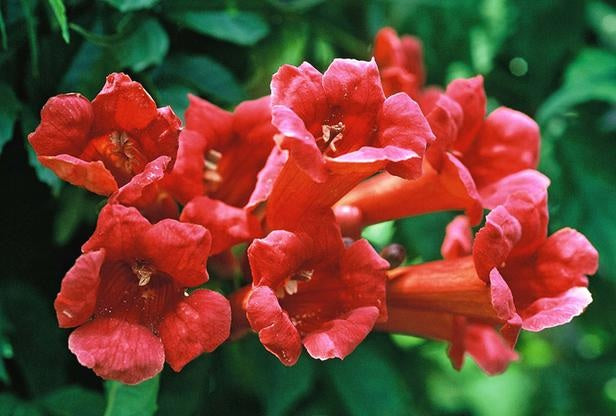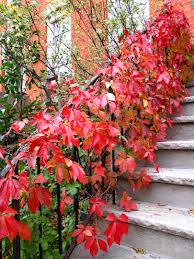 If you haven’t fertilized your yard within the last few weeks, the start of the monsoon season is the time to feed for increased summer blooms. This is especially important for plants stressed by spider mites, from being wind whipped, or just plain ol’ yellow and sickly looking. It’s no secret that my favorite plant food is the one I created after years of mountain gardening. I call it ‘All Purpose Plant Food’ 7-4-4. It is designed specifically for gardens in the mountains of Arizona so in our area it works better than the national brands. Simply sprinkle it throughout the yard and garden and the next rain will activate the nutrients. I just had the pros at the nursery fertilize every tree we have in stock. The trees were looking pale and obviously in need of a nutritious pick-me-up. It’s been a week since they were fed my home grown organic food, and they look better already!
If you haven’t fertilized your yard within the last few weeks, the start of the monsoon season is the time to feed for increased summer blooms. This is especially important for plants stressed by spider mites, from being wind whipped, or just plain ol’ yellow and sickly looking. It’s no secret that my favorite plant food is the one I created after years of mountain gardening. I call it ‘All Purpose Plant Food’ 7-4-4. It is designed specifically for gardens in the mountains of Arizona so in our area it works better than the national brands. Simply sprinkle it throughout the yard and garden and the next rain will activate the nutrients. I just had the pros at the nursery fertilize every tree we have in stock. The trees were looking pale and obviously in need of a nutritious pick-me-up. It’s been a week since they were fed my home grown organic food, and they look better already!
To increase root growth and help stabilize stressed out plants there is an additional step to proper garden health. At the same time that you apply ‘All Purpose Plant Food’, also administer a good strong dose of ‘Soil Activator’. It is easy to use and guaranteed to increase root mass in summer. This is very important for those new additions to the garden, for pale and sick plants, and for plants under attack by grubs, mites, and aphids. Increased root masses can help plants’ developments, especially in the herb and vegetable gardens. Soil Activator increases root mass while other plant food increases foliage and flower mass. This dynamic combination can bring new life to just about any plant.
 Have you noticed lush green vines in bloom with spectacular orange-to-red flowers? These are trumpet vines, Campsis radicans, perennial bloomers that have brightened our area for a long time. The plant is rather unassuming most of the year but its sudden show of such large bright flowers is breathtaking. The vine is covered with dozens of four-inch wide, vase-shaped flowers right into fall. Hummingbirds will snack on the blossoms even after the entire plant turns its brilliant shades of autumn gold.
Have you noticed lush green vines in bloom with spectacular orange-to-red flowers? These are trumpet vines, Campsis radicans, perennial bloomers that have brightened our area for a long time. The plant is rather unassuming most of the year but its sudden show of such large bright flowers is breathtaking. The vine is covered with dozens of four-inch wide, vase-shaped flowers right into fall. Hummingbirds will snack on the blossoms even after the entire plant turns its brilliant shades of autumn gold.
For the best color, trumpet vines like at least six hours of sun. However, good drainage is the key to exceptional growth and the brightest colors. When planted in a wide hole then filled in with heavily mulched native soil, a trumpet vine will thrive. Once established, this plant is a moderate to low water user.
Around town there are large specimens of trumpet vines that have grown to about 12 feet high by 12 feet wide. However, many of my customers easily keep this vine pruned to a lower height. When a trumpet vine is happy you can expect it to grow six feet or more in a year. If you have a yard with erosion issues, keep in mind that this plant is great at retaining soil.
 When asked about vines for erosion control I always suggest the Virginia creeper. Although native to the state of Virginia, I have seen this vine growing wild throughout the Bradshaw mountain range. Its strong, steady growth can easily cover a hillside. In fall Virginia creepers have a striking red color that rivals that of maples and burning bush. It’s beautiful, drought hardy, and easy to grow. Now, that’s some vine!
When asked about vines for erosion control I always suggest the Virginia creeper. Although native to the state of Virginia, I have seen this vine growing wild throughout the Bradshaw mountain range. Its strong, steady growth can easily cover a hillside. In fall Virginia creepers have a striking red color that rivals that of maples and burning bush. It’s beautiful, drought hardy, and easy to grow. Now, that’s some vine!
The cloud cover during the monsoon rains makes this the ideal time to plant vines. This goes for fruiting vines like grapes and berries, and for the tropical-looking trumpets and honeysuckles. The increased humidity with occasional afternoon rain nurtures a pronounced increase of planting successes. I have found that, unique to the mountains of Arizona, my summer plantings are more successful than vines planted in spring. Truly, for some plants it pays off to wait for the first rains of July.
See more examples of local vines at Watters Vine Archives.
 Garden Class – Saturday (9:30 – 10:30 a.m.) Bonsai Expert 101
Garden Class – Saturday (9:30 – 10:30 a.m.) Bonsai Expert 101
Bonsai expert Frank Cuva will teach a beginning level class about the creation of a bonsai plant. During the class, students are shown the basics of transplanting and shaping. The class is free, but students should bring small pruners, gloves, and their enthusiasm for this amazing art form. If you click with the gardeners in attendance and the atmosphere of the class, consider joining this start up ‘Bonsai Club’. It’s an opportunity to share all things bonsai, from failures and successes to bonsai-related travel stories.
~ * ~
All of our gardening classes are held on Saturdays, beginning promptly at 9:30 a.m. They are fun, and full of useful information. You will learn many of the tips and tricks for cultivating successful local gardens. Garden Classes
Tell a friend – If you find these garden tips helpful and want to share them with friends, point them to this link for the High Country Garden Club.
Until next week, I’ll see you in the garden center.
Ken Lain can be found throughout the week at Watters Garden Center, 1815 W. Iron Springs Rd in Prescott, or contacted through his web site at www.wattersgardencenter.com or Facebook page https://www.facebook.com/watters1815

